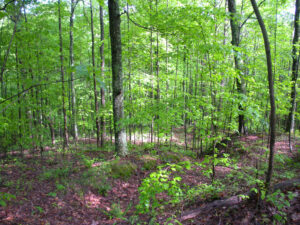Forest Dynamics

Project Investigators
Mike Saunders, Purdue University, msaunder@purdue.edu
Mike Jenkins, Purdue University, jenkinma@purdue.edu
In Indiana and the entire Central Hardwood Region, many species are dependent upon oak/hickory forests. However, for many years, these forests have been allowed to grow without harvest or fire, and the result is that the understory of these woods is now filled with species such as maples and beeches. As a result, land managers are faced with the task of determining how and when to intervene through silviculture and other methods like prescribed fire.
Inventory plots on a grid system are used throughout the HEE to characterize the long-term, landscape-level changes in forest canopy structure and overstory recruitment by oak and other tree species in response to forest management. These plots will also allow spatial modeling of oak regeneration in response to overstory canopy and other environmental valuables, thereby linking local, seed dispersal mechanisms to landscape patterns. Regeneration data is also recorded at these same plots. Plots are installed across all treatment types on a 75 meter by 150 meter grid, linking them to avian inventories and the prescribed fire grid.
Key Papers:
- Kellner, K.F. and R.K.Swihart. 2016. Timber harvest and drought interact to impact oak seedling growth and survival in the Central Hardwood Forest. Ecosphere 7(10): e01473
- Olson, M.G. and M.R. Saunders. 2017. Long-term research on managed hardwood forests in eastern North America. Forest Ecology and Management, 387: 1-2.
- Murray, B.D., J.D. Holand, K.S. Summerville, J.B. Dunning, M.R. Saunders, and M.A. Jenkins. 2017. Functional Diversity response to hardwood forest management varies across taxa and spatial scales. Ecological Applications 1002/eap.1532
- Kellner, K.F. and R.K. Swihart. 2017. Herbivory on planted oak seedlings across a habitat edge created by timber harvest. Plant Ecology, 218:213-223.
- Kellner, K.F. and R.K. Swihart. 2017. Simulation of oak early life history and interactions with disturbance via an individual-based model, SOEL. PLoS ONE 12(6): e0179643. https://doi.org/10.1371/journal.pone.0179643
Digital Forestry
Project Investigator
Songlin Fei, Purdue University, sfei@purdue.edu
https://ag.purdue.edu/digital-forestry/
Sustainable forest management requires detailed inventories of tree quantity and quality to support informed management decision making, which in turn, can significantly impact the potential for forest resources to meet economic and ecological needs. Forest inventory data is currently collected using manual field sampling techniques, often relying on observations by trained experts, introducing substantial sources of error and reducing reproducibility of data collection effort. Recent technological advances offer new methods and techniques that can increase the accuracy of tree quantity and quality measurements, and are cheaper and faster than conventional approaches.
We plan to modernize forest inventory at the Hardwood Ecosystem Experiment (HEE) site by developing methods that take advantage of recent advances in aerial remote sensing technologies and the vastly available ground data. Specifically, we plan to (1) test the feasibility of automated individual tree delineation and biometrics measurement for natural hardwood forests at HEE using unmanned aerial system (UAS) LiDAR and multispectral images, and (2) test the feasibility of UAS based invasive species mapping.
Acorn Production
 Project Investigator
Project Investigator
Robert K. Swihart (Retired), Purdue University, (765) 494-3575, rswihart@purdue.edu
Mike Saunders, Purdue University, msaunder@purdue.edu
Dr. Swihart is studying acorn production and removal of fallen acorns to determine which consumers in the forest community are benefiting from this important food supply, how use varies with food availability and consumer density, and whether differences occur due to tree harvesting. Acorn traps have been placed under the canopies of >100 oak trees, and acorns collected by traps are counted during regular checks from August-December. A subset of acorns is x-rayed each year to determine whether they are infested by acorn weevils. At each tree, a series of semi-permeable enclosures is used to restrict access to acorns by vertebrates of different size, from deer to mice. During the first 6 years post-harvest, there was little effect of silvicultural treatments on acorn production except for a reduction in black oak acorns along opening edges. Weevil infestation was reduced following midstory removal in shelterwood treatment sites, and predation pressure by weevils and vertebrates was greatest during years of low acorn production (Kellner, Riegel, and Swihart 2014). Mast production also was associated with relative abundance of white-footed mice and short-tailed shrews the following summer (Kellner, Urban, and Swihart. 2013). Acorn production and weevil infestation data also were used to build a model to simulate the importance of multiple aspects of oak early life history and demography on oak regeneration success. Regeneration success was most sensitive to acorn production, the probability of acorn caching by scatter hoarding rodents, and seedling growth rates (Kellner and Swihart 2017). In related work, we studied the dispersal of acorns and found that acorns from sites treated with midstory removal were more likely than untreated sites to be taken by granivores and were less likely to survive the winter, resulting in a 67% reduction in seed dispersal effectiveness (Kellner, Lichti and Swihart 2016).
Key Papers:
- Kellner, K.F., J.R. Riegel and R.K. Swihart. 2014. Effects of silvicultural disturbance on acorn infestation and removal in the central hardwood forest region. New Forests, 45(2): 265-281.

